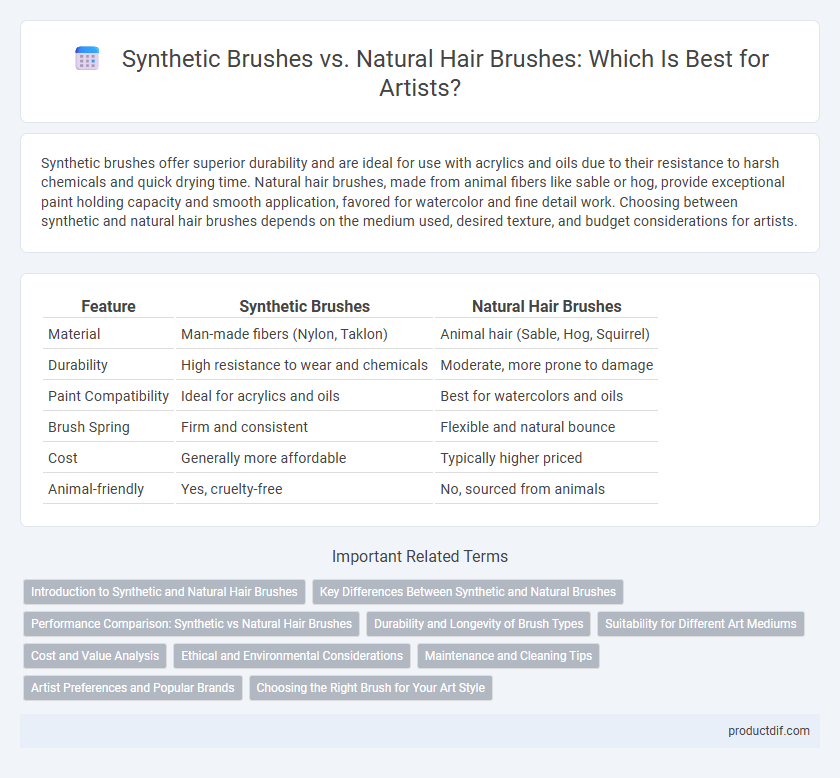Synthetic brushes offer superior durability and are ideal for use with acrylics and oils due to their resistance to harsh chemicals and quick drying time. Natural hair brushes, made from animal fibers like sable or hog, provide exceptional paint holding capacity and smooth application, favored for watercolor and fine detail work. Choosing between synthetic and natural hair brushes depends on the medium used, desired texture, and budget considerations for artists.
Table of Comparison
| Feature | Synthetic Brushes | Natural Hair Brushes |
|---|---|---|
| Material | Man-made fibers (Nylon, Taklon) | Animal hair (Sable, Hog, Squirrel) |
| Durability | High resistance to wear and chemicals | Moderate, more prone to damage |
| Paint Compatibility | Ideal for acrylics and oils | Best for watercolors and oils |
| Brush Spring | Firm and consistent | Flexible and natural bounce |
| Cost | Generally more affordable | Typically higher priced |
| Animal-friendly | Yes, cruelty-free | No, sourced from animals |
Introduction to Synthetic and Natural Hair Brushes
Synthetic brushes, typically made from nylon or polyester fibers, offer durability, affordability, and ease of cleaning, making them ideal for acrylics and heavy-bodied paints. Natural hair brushes, sourced from animals like sable, hog, or squirrel, provide superior paint retention and smooth application, favored for watercolors and oil painting. Both brush types vary in stiffness, shape, and performance, influencing the artist's control and finish depending on the medium used.
Key Differences Between Synthetic and Natural Brushes
Synthetic brushes feature fibers made from man-made materials like nylon or polyester, offering durability, resistance to damage from solvents, and consistent performance ideal for acrylics and oils. Natural hair brushes, derived from animal sources such as sable, hog, or squirrel, provide superior paint pickup, smooth application, and excellent flexibility, making them preferred for watercolor and fine detail work. The key differences lie in fiber source, resilience to chemicals, texture, and suitability for various paint mediums.
Performance Comparison: Synthetic vs Natural Hair Brushes
Synthetic brushes offer superior durability and maintain firm bristle shape when used with acrylic and oil paints, making them ideal for heavy-bodied mediums. Natural hair brushes, such as sable or hog bristle, excel in water retention and smooth paint application, providing enhanced control and softer strokes with watercolor and delicate glazing techniques. Performance varies by art medium, with synthetics favored for robustness and versatility, while natural hair brushes remain preferred for precision and traditional painting textures.
Durability and Longevity of Brush Types
Synthetic brushes, typically made from nylon or polyester fibers, offer exceptional durability and resist wear over time, maintaining shape and stiffness even with frequent use. Natural hair brushes, derived from animal fur such as sable or hog bristle, provide superior paint retention and smooth application but tend to degrade faster, with bristles becoming splayed or brittle after prolonged exposure to solvents and heavy usage. Artists seeking long-lasting tools often prefer synthetic brushes for their resilience, while natural hair brushes require more careful maintenance to optimize longevity.
Suitability for Different Art Mediums
Synthetic brushes excel in acrylic and oil painting due to their durability and resistance to chemicals, making them ideal for heavy-bodied paints and repeated washing. Natural hair brushes, such as sable or hog bristle, offer superior water retention and flexibility, which enhances the control and blending capabilities needed for watercolor and delicate ink work. Selecting between synthetic and natural hair brushes depends on the medium's viscosity and desired texture, ensuring optimal performance and artistic precision.
Cost and Value Analysis
Synthetic brushes generally offer a more affordable option compared to natural hair brushes, often costing 30-50% less while maintaining durability and ease of cleaning. High-quality synthetic brushes can mimic the performance of natural hair, providing excellent paint retention and smooth application, which enhances their overall value for budget-conscious artists. Natural hair brushes, although pricier, excel in precision and versatility, often justifying their higher cost for professional use and advanced techniques.
Ethical and Environmental Considerations
Synthetic brushes offer a cruelty-free alternative to natural hair brushes, eliminating the need for animal hair harvesting and reducing ethical concerns for artists prioritizing animal welfare. Environmentally, synthetic materials often involve petroleum-based production but can be more sustainable when sourced from recycled plastics or designed for durability, minimizing waste. Natural hair brushes, while biodegradable, contribute to environmental pressures through animal farming and harvesting practices, making the choice between synthetic and natural brushes a balance between ethical responsibility and ecological impact.
Maintenance and Cleaning Tips
Synthetic brushes require less maintenance than natural hair brushes due to their resistance to water and paint buildup, making them ideal for acrylic and oil painting. Clean synthetic brushes with warm water and mild soap after each use to prevent bristle damage and prolong their lifespan. For natural hair brushes, use specialized brush cleaners and conditioner to maintain hair flexibility and avoid shrinkage or warping during the cleaning process.
Artist Preferences and Popular Brands
Artists often prefer synthetic brushes for their durability, ease of cleaning, and affordability, while natural hair brushes are favored for their superior paint retention and softer textures. Popular synthetic brush brands include Princeton and Winsor & Newton, known for high-quality nylon and taklon fibers, whereas Escoda and Isabey are renowned for premium natural hair brushes made from sable and hog bristle. Preference largely depends on the medium and technique, with synthetic brushes excelling in acrylics and watercolors, and natural brushes dominating oil painting.
Choosing the Right Brush for Your Art Style
Synthetic brushes offer durability and versatility, making them ideal for acrylics and heavy-bodied paints, while natural hair brushes excel in holding water and pigment, perfect for delicate watercolor techniques. Artists seeking precision and smooth blending often prefer sable or squirrel hair brushes due to their fine tips and softness. Evaluating your preferred medium and painting style ensures selecting the right brush, enhancing control and texture in your artwork.
Synthetic Brushes vs Natural Hair Brushes Infographic

 productdif.com
productdif.com